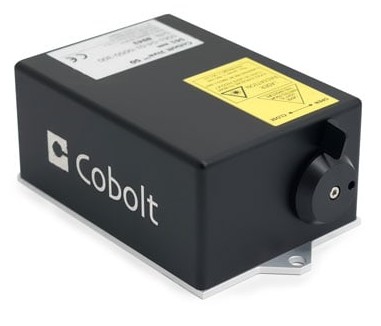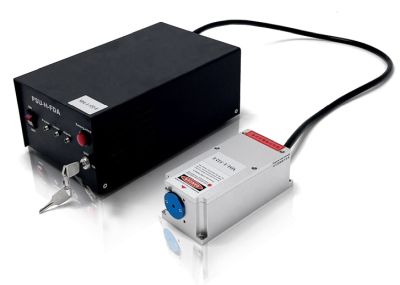end pumping (original) (raw)
Definition: a technique of optically pumping a laser medium in a direction along the laser beam
Categories:  laser devices and laser physics,
laser devices and laser physics,  methods
methods
Related: optical pumpinglaserssolid-state lasersside pumpinglaser gain mediabeam qualityThe Ideal Pump Intensity Distribution in an End-Pumped Solid-State Laser
Opposite term: side pumping
Page views in 12 months: 787
DOI: 10.61835/ona Cite the article: BibTex BibLaTex plain textHTML Link to this page! LinkedIn
Content quality and neutrality are maintained according to our editorial policy.
📦 For purchasing diode-pumped lasers, use the RP Photonics Buyer's Guide — an expert-curated directory for finding all relevant suppliers, which also offers advanced purchasing assistance.
Contents
What is End Pumping?
End pumping (also sometimes called longitudinal pumping) of lasers and optical amplifiers is a technique of optically pumping a laser gain medium, where the pump light is injected along the laser beam, rather than in a transverse direction (side pumping).

Figure 1: Setup of a typical end-pumped solid-state laser.
Benefits of End Pumping
The geometry of end pumping often allows one to achieve a good spatial overlap between pump and laser radiation. That in turn can have multiple benefits:
- It is possible that way to obtain a high laser gain. That is also particularly important for optical amplifiers.
- One can also achieve a high power efficiency (usually higher than with side pumping), since one avoids pumping regions which cannot participate in the laser process.
- If the pump beam stays well within the volume of the fundamental transverse mode of the laser resonator (at least within the laser crystal), transverse single-mode operation with diffraction-limited beam quality is often possible because higher-order modes then have too low gain to reach the laser threshold. (A laser beam radius somewhat below the radius of the pump intensity distribution is often required, since otherwise the laser mode is affected by the optical aberrations of the thermal lens, particularly for high pump power levels and intensity distributions which deviate strongly from a flat-top shape.)
For these reasons, most diode-pumped solid-state lasers, particularly those with lower output powers, are end-pumped.
Limitations
There are also various potential disadvantages of end pumping:
- Pump light can be injected only from at most two directions, and that may limit the applicable total pump power.
- Particularly for pumping a long laser crystal with a small beam radius, one requires a pump source with high beam quality, or in combination with a certain level of optical power a high radiance (brightness). Therefore, lamp-pumped lasers, for example, can usually not be end-pumped.
- The optical intensity and the crystal temperature vary along the beam direction — particularly for unidirectional pumping, but substantially less for bidirectional pumping.
Due to these limitations, end pumping often cannot be used for high-power lasers, and in particular not for lamp-pumped lasers. There are techniques, however, to extend the end pumping concept to fairly high powers; for example, multi-segmented rods (→ composite laser crystals) can be used for better distributing the absorbed power.
Frequently Asked Questions
What is end pumping of a laser?
End pumping, also called longitudinal pumping, is a technique for optically pumping a laser gain medium where the pump light is injected along the axis of the laser beam, rather than from a transverse direction (side pumping).
What are the main advantages of end pumping?
End pumping allows for excellent spatial overlap between the pump and laser beams. This results in high laser gain, high power efficiency, and often diffraction-limited beam quality for single-mode operation.
What are the disadvantages of end pumping?
The main disadvantages are the limited total pump power, as light can only be injected from at most two ends, and the need for a pump source with high brightness (radiance).
Why is end pumping suitable for diode-pumped lasers but not lamp-pumped lasers?
End pumping requires a high-brightness pump source that can be focused into a small volume. Laser diodes provide this, whereas lamps do not have sufficient radiance for efficient end pumping.
Suppliers
Sponsored content: The RP Photonics Buyer's Guide contains 129 suppliers for diode-pumped lasers. Among them:
⚙ hardware
As a breakthrough in DPSS laser technology, the MirPac is a 2.94-μm Er:YAG laser with TEM00 output beam in a hermetically sealed windowed package that was the first of its kind. Operating at 2940 nm, the wavelength with strongest absorption in water, the MirPac is ideal for use in tandem with water or with materials that contain some amount of water.
⚙ hardware
HÜBNER Photonics specializes in providing high-quality continuous-wave diode-pumped lasers (DPLs) suitable for a range of applications. These lasers are available in wavelengths from 355 nm to 1064 nm and are designed for single-longitudinal mode operation, ensuring excellent noise and power stability.
For more detailed specifications and potential applications, please visit the HÜBNER Photonics website.
⚙ hardware
ALPHALAS offers advanced diode-pumped solid-state lasers with pulse durations in the nanosecond or picosecond region, as well as CW lasers. Different types of pulsed diode-pumped lasers include:
- actively or passively mode-locked picosecond lasers,
- regeneratively amplified lasers,
- actively and passively Q-switched lasers, and
- mode-locked and cavity-dumped lasers.
Customer-specific repetition rates and pulse energies are available on request. Some models can operate at single longitudinal mode in CW or pulsed mode. Optionally available are also second, third or fourth harmonics for most of the above lasers.
⚙ hardware
Monocrom offers diode-pumped solid state lasers for medical, material processing, LiDAR and spectroscopy applications as well as for laser pumping:
- LQ-527-12: a frequency-doubled Nd:YLF laser emitting up to 1 mJ at 527 nm
- Multi-Path 532: a photocoagulation laser emitting up to 8 W cw or 15 W qcw at 532 nm
- CiOM lasers emitting nanosecond pulses at 526.5 nm
⚙ hardware
Teem Photonics offers air-cooled diode-pumped passively Q-switched lasers — the Microchip laser series and the more powerful Powerchip laser series. Higher average power versions are based on a MOFA architecture, i.e., using a fiber amplifier. All can generate intense sub-nanosecond pulses. Available emission wavelengths are 1064 nm, 532 nm, 355 nm, 266 nm and 213 nm.
⚙ hardware
GWU-Lasertechnik provides diode-pumped solid-state laser solutions with wavelength conversion. The sophisticated optical and mechanical design and the soft pumping scheme ensure excellent performance, highest reliability and longest lifetime. Continuous, gap-free tunability from the deep-UV at <190 nm to the infrared spectral range at >2700 nm is offered for best usability.
⚙ hardware
Serving North America, RPMC Lasers offers diode-pumped lasers in pulsed and CW configs, customizable, compact, rugged, with varied power for diverse uses.
Our Pulsed DPSS lasers feature UV, visible, IR wavelengths to 5th harmonic, active/passive Q-switching for ns, ps & fs pulses, pulse energies from nJ to 100s of mJ, from single pulse to 80 MHz repetition rate, high brightness, and efficient absorption.
Our CW DPSS lasers provide UV to NIR options, single/multimode, narrow linewidth, stabilized outputs, integrated thermal/electrical modules, OEM or plug-and-play setups with free-space/fiber output from mW to watts.
Let RPMC help you find the right laser today!
⚙ hardware
Bright Solutions offers a range of diode-pumped solid-state lasers, including
- Wedge — nanosecond Q-switched lasers for 266, 355, 532, 1064, 1570, 3100 nm (also multi-wavelength configurations), used e.g. for atmospheric LIDAR, monitoring, glass machining or lithography
- Onda — compact monolithic nanosecond Q-switched lasers for 266, 355, 532 or 1064 nm, used e.g. for lens marking, plastic marking or intravolume glass marking
- Sol — compact Q-switched lasers for 355, 532 or 1064 nm, up to 200 kHz, used e.g. for automotive fabrication, electronic machining, ID card writing and other industrial applications
- Vento — sub-nanosecond MOPA lasers with pulse durations down to 500 ps, up to 200 kHz, up to 100 W average power at 1064 nm or 50 W at 532 nm, e.g. for LIDAR or PCB microprocessing
- Aero — high energy lasers with up to 200 mJ at 1064 nm, 100 mJ at 532 nm, multi-wavelength configurations, custom beam shaping, application e.g. in atmospheric LIDAR, LIBS or nonlinear spectroscopy
- BDL and BFD — fiber-coupled diode laser modules with up to 200 W cw (or 400 W quasi-cw) in a 200-μm core fiber, e.g. for pumping of solid-state and fiber lasers, material processing or illumination; pulsed models are available
- NPS — narrowband picosecond lasers for applications like OPO pumping, Raman or fluorescence spectroscopy and multimodal imaging
- ONE DPSS — miniaturized Q-switched lasers with up to 200 μJ and down to 3 ns, e.g. for atmospheric LIDAR and laser marking on plastics
⚙ hardware
Vertical-External-Cavity Surface-Emitting Lasers (VECSELs), also known as semiconductor disk lasers or optically pumped semiconductor lasers, provide a versatile platform with features beneficial for applications requiring broad wavelength coverage and high output power. Key features include:
- Broad wavelength coverage
- Multi-watt power output
- Low noise
- Excellent spatial quality
- Tunable narrow-linewidth operation
VECSELs are suitable for applications that demand exotic wavelengths and high power with narrow spectral linewidths.
⚙ hardware
CSRayzer's high quality pump laser diodes with butterfly package can provide high output powers for fiber amplifiers. The built-in thermo-electric cooler (TEC) can make the laser diode work properly in various environments.
⚙ hardware
The large range of Lumibird pulsed nanosecond solid-state lasers includes diode-pumped models, from 5 mJ to 1.5 J at 1064 nm, from single pulse to 400 Hz. These lasers can be integrated into a system thanks to their compactness and robustness, or used as stand-alone devices. Several wavelengths are available, including 1.57 µm.
⚙ hardware
CNI offers the widest range of diode-pumped lasers not only in terms of wavelength, but also concerning various features: we have single-frequency lasers, narrow linewidth lasers, low noise lasers, high power and energy lasers, mode-locked and picosecond lasers and Q-switched lasers.
Questions and Comments from Users
Here you can submit questions and comments. As far as they get accepted by the author, they will appear above this paragraph together with the author’s answer. The author will decide on acceptance based on certain criteria. Essentially, the issue must be of sufficiently broad interest.
Please do not enter personal data here. (See also our privacy declaration.) If you wish to receive personal feedback or consultancy from the author, please contact him, e.g. via e-mail.
By submitting the information, you give your consent to the potential publication of your inputs on our website according to our rules. (If you later retract your consent, we will delete those inputs.) As your inputs are first reviewed by the author, they may be published with some delay.






















